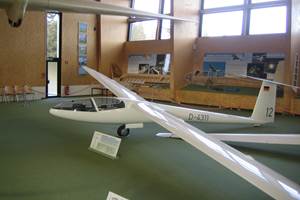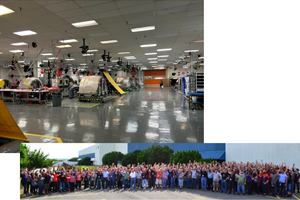Update: Automated repair cell
Consortium makes progress on aircraft component diagnostics/repair cell concept.
Publicly unveiled in 2005, the Inspection and Repair Preparation Cell (IRPC) concept is the result of an initiative begun in 1999 to improve aircraft repair practices and reduce repair time through automation. The ongoing work of a consortium of companies championed by American GFM (AGFM, Chesapeake, Va., a member of the GFM machine tool organization headquartered in Steyr, Austria), the IRPC is designed to integrate into a single automated work cell a variety of tasks regularly performed manually by aircraft maintenance and repair organizations (MROs).
An IRPC “cell” currently includes a 3-D digitizing station, nondestructive testing (NDT) capability, radio frequency identification (RFID) tagging, automated machining equipment (to remove damage and cut out repair plies and core plugs) and advanced in-cell collision avoidance technologies. Potential cell features include automated finite element analysis (FEA) to assist repair technicians (see “Related Content,” at left). Intended initially for repairs of nose radomes on C-130 military transport aircraft and radomes and speed brakes on the F-15 jet fighter, IRPC cells would increase the work pace for frequent and critical aerospace composite repairs. Future cell configurations could include advanced manufacturing capability, such as automated preforming for resin transfer molding or other infusion methods.
AGFM’s advanced initiatives coordinator Frank Elliott reports that the group made important strides in 2006, based on feedback from four technology conferences sponsored by the consortium across the country. The initial meeting, held Feb. 9, 2006, in Chesapeake, Va., was the subject of the HPC May 2006 report. Interest generated at that gathering prompted three more meetings in Wichita, Kan. (June 22), Salt Lake City, Utah (Aug. 23) and Seattle, Wash. (Nov. 15). Attendees included representatives from The Boeing Co.’s Seattle facilities as well as composite parts manufacturers involved not only in aerospace but other sectors, such as transportation, as well.
AGFM used the meetings to highlight improvements in the advanced machine tool functions that will be included in the IRPC cell concept. As presented by Brad Fair, AGFM’s manager of mechanical engineering, these include enhancements to ultrasonic ply cutting, dispensing and marking systems; an increased number of ultrasonic cutting tools and horns; and major improvements in the honeycomb core machining process, using the company’s 6-axis Ultrasonic Core Sculpting Machines and systems.
GFM introduced a flat tape-laying system with an automated, multiple-head changer for layups that require more than one material type. The system includes an interface to a Production Planning System (PPS) and can generate part programs automatically, says GFM’s mechanical engineering manager Harald Dietachmayr and Dr. Erich Zarzer, manager of mathematical engineering and software development. As proof of its automation expertise, GFM recently designed, manufactured and delivered a mammoth automated composites production cell, measuring 50m by 70m (162.5 ft by 228 ft), to an aerospace customer. The cell comprises a 6-axis ultrasonic cutting machine, a 4-axis ultrasonic ply cutter, a flat-tape laying system, a composite-forming press and automated tool and material handling system, all with individual CNC controllers. The entire production process is governed by a PC-based cell controller that activates the machines and transfer units and collects data for production documentation. Although this customer will be producing production parts as long as 16m/52 ft, Dietachmayr contends that all the concepts used in this production cell are applicable to MRO cells.
AGFM’s consortium partners also have been optimizing technologies they intend to contribute to the IRPC effort. Dimensional Photonics International Inc. (DPI, Wilmington, Mass.) has improved its 3-D digital shape scanner, which enables accurate part shape detection. To get the geometric data necessary to replace a manual tap test, DPI’s technology automatically and rapidly generates an electronic surface grid with a noncontact 3-D digitizing system based on accordion fringe interferometry (AFI), which was developed at the Massachusetts Institute of Technology (MIT, Cambridge, Mass.). A laser mounted on the end of a robotic arm illuminates the object with an interference fringe pattern achieved by splitting a laser beam into two point sources. For contoured parts, the illumination fringes are detected by a camera, and the AFI algorithm triangulates the surface topology, creating a data point cloud — essentially a 3-D photo of the part. This image, accurate to within 0.002 inch, forms a baseline for downstream repair activities. The company’s AFI 5000P digital shape scanning device can perform scans accurate to within several microns in a few seconds, says DPI’s Scott Ackerson. “The technology provides high accuracy in a plant floor environment for reverse engineering, inspection or process control.”
Another key repair cell element is a means to verify that the correct repair materials have been installed in the correct orientation. Assembly Guidance Systems Inc. (Chelmsford, Mass.) offers a laser projection system called Micro-LASERGUIDE with Automatic Ply Verification (APV), AutoFocus and AutoAim. Already FAA-approved, the system automatically projects sharp, visible lines that guide a technician to the right position for the repair plies, says president Scott Blake. To demonstrate its utility for repair, MicroLASERGUIDE has been integrated into AGFM’s automated cutting and automated robotic assembly together with handling jigs provided by consortium partner Romeo Engineering (Ft. Worth, Texas). Sikorsky Aircraft Corp. (Stratford, Conn.) is using LASER-GUIDE with APV for inspection during helicopter rotor blade production (see near photo). APV provides automated, in-process quality monitoring and meets Sikorsky and FAA inspection requirements for part characteristics that are critical to flight safety, verifying fiber orientations to an accuracy of ±2°, reports Blake.
Consortium partner Photo Emission Technology Inc. (Camarillo, Calif.), offers two technologies that company president Mantosh Chawla believes have possibilities in repair cell applications. One is a portable, capacitance-based inspection instrument that determines part surface roughness, an indicator of foreign object damage (FOD). The second is photo emission technology or photo electron emission technology, also used for surface inspection. “Both of these techniques can detect the presence of foreign debris before repair plies are layed down, and either can function as an on-the-fly, in-process inspection tool,” explains Chawla.
In the event that a repair cell requires a liquid molding process, AGFM also has at its disposal the CompForm automated preforming solution, which can be coupled with partner firm Comtek Advanced Structures Ltd.’s (Burlington, Ontario, Canada and Phoenix, Ariz.) patented SmartFlow resin infusion technology. CompForm uses low-energy-curing thermoset binders that can stabilize 3-D preforms assembled from any combination of reinforcement forms, including engineered fabrics and mats and most core materials. For fiberglass, a UV-curable binder typically is used, while carbon reinforcements are held together with an anaerobic curing binder. Neither binder requires a heating system, which should help simplify automated cell design. CompForm preforms can be near-net shape or net shape, depending on the molding process and application demands, reports AGFM’s Dan Buckley.
Currently, the repair cell consortium is moving forward. One related initiative, involving AGFM, Dimensional Photonics, Assembly Guidance and Abaris Training Resources Inc. (Reno, Nev.), is termed ADRI, for Advanced Defect Repair Inspection. ADRI will focus on detecting and repairing defects during manufacturing processes, says Elliott.
The ADRI group is concentrating on combining scarfing (damage removal via automated machining); 3-D digitizing and shape scanning of the scarfed surfaces; application of 3-D to 2-D conversion software to permit laser projection of repair ply outlines onto the scarfed areas; and complete integration of all of these functions using a cell controller. Training of personnel is also an important function of the ADRI process. For that reason, Abaris is a key consortium partner, notes Elliott. New partner Voss Scientific LLC (Albuquerque, N.M.) is involved in improving nondestructive inspection (NDI) of composite parts via microwave, millimeter wave and other technologies for both the IRPC and ADRI concepts.
“We’ve got at least six regional conferences planned for 2007,” says Elliott. HPC will continue to monitor this key topic and note conference dates and locations in our calendar.
For additional information, contact Frank Elliott, featgfm@aol.com.
Related Content
Chemnitz University of Technology receives €6 million to expand research into "green" carbon fiber
Carbon LabFactory and InnoCarbEnergy project conduct R&D across entire value chain from raw materials through processes to structures and systems on a pilot line with technology demonstrators.
Read MoreFrom sailplanes to composites repair: Growing composite training opportunities over the years
Mike Hoke discovered his interest in the composites industry at a young age. His journey eventually led him to Abaris Training Resources, which he owned and evolved for more than 30 years.
Read MoreCreating a culture of excellence in aerocomposites
ST Engineering MRAS discusses the importance of addressing human factors to reduce separator inclusion in bonded structures.
Read MoreUniversity of Maine unveils 100% bio-based 3D-printed home
BioHome3D, made of wood fibers and bioresins and entirely 3D printed, highlights Maine’s effort to address the need for more affordable housing.
Read MoreRead Next
Composites end markets: Energy (2024)
Composites are used widely in oil/gas, wind and other renewable energy applications. Despite market challenges, growth potential and innovation for composites continue.
Read MoreFrom the CW Archives: The tale of the thermoplastic cryotank
In 2006, guest columnist Bob Hartunian related the story of his efforts two decades prior, while at McDonnell Douglas, to develop a thermoplastic composite crytank for hydrogen storage. He learned a lot of lessons.
Read MoreCW’s 2024 Top Shops survey offers new approach to benchmarking
Respondents that complete the survey by April 30, 2024, have the chance to be recognized as an honoree.
Read More


















.jpg;maxWidth=300;quality=90)









